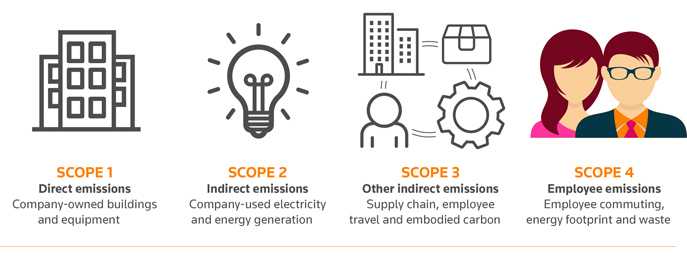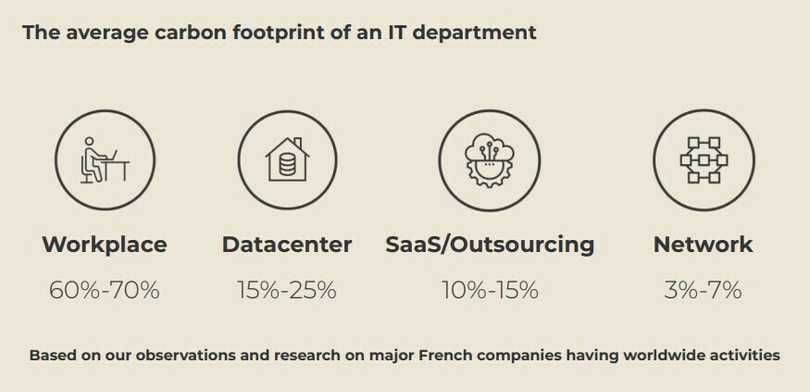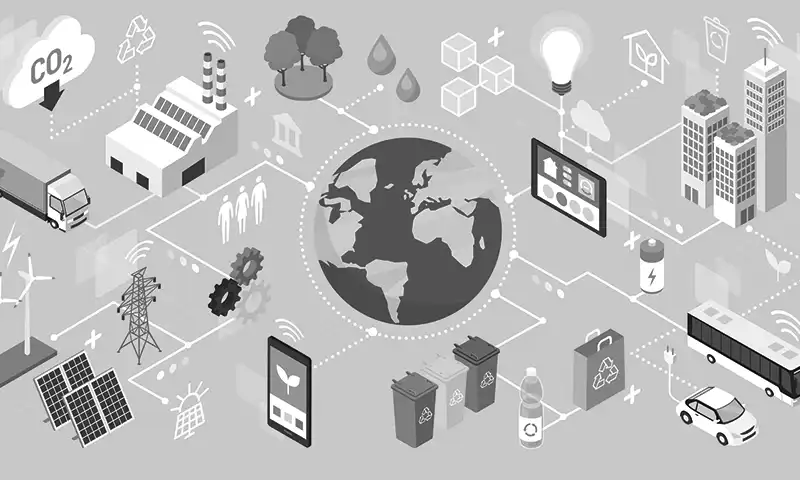How do Scopes 1, 2 and 3 apply to digital technologies and IT ?
Carbon footprints are more topical than ever: in early 2023, the BEGES decree from the Ministry of Ecological Transition updated and specified the process to be carried out for companies, in order to accurately measure their carbon footprint and act accordingly to the results. Although the decree replaced the Scopes by 6 categories of GHG emissions, they remain the reference method for determining the scope of a GHG assessment.
But in terms of carbon emissions, are we talking enough about digital? According to a study published last month by ADEME-Arcep, 3 to 4% of global greenhouse gas emissions are due to digital technology, and this figure could triple by 2050. To act in favor of a responsible and sustainable digital world, we must first of all define the scope of our digital footprint. The Scopes, applied to digital, offer us a better understanding of the issues at stake but also of the action levers to be activated!
Scopes 1, 2 and 3: an effective way to categorize greenhouse gas emissions
As a reminder, Scopes (literally "scope" or "perimeter" in English) are categories used to classify the greenhouse gas emissions of companies. Indeed, companies account (not surprisingly) for a large part of the world's carbon footprint: determining their emissions is the first step in taking action.
A little history... 📜
Carbon emission Scopes were first introduced by the Greenhouse Gas (GHG) Protocol, an international standard for calculating the carbon footprint of companies and organizations created in the late 1990s by the World Resources Institute and the World Business Council for Sustainable Development.
The Scopes therefore correspond to different perimeters, and are categorized as follows:
Scope 1 corresponds to direct emissions from the combustion of fossil fuels (oil, gas, coal, peat). More generally, Scope 1 corresponds to the carbon footprint associated with the manufacture of material products.
Scope 2 concerns a company's energy consumption, whether it be electricity or heating. All industries need electricity to operate, so Scope 2 must be systematically calculated.
Finally, Scope 3 concerns indirect emissions and often represents the most significant part of a GHG assessment. It includes emissions generated by suppliers and customers during the life cycle of a product or service.

What about Scope 4, then?
Scope 4 is about what are called "avoided emissions": greenhouse gas emissions that would have been generated by the customer or end user when using the product or service.
Instead of measuring the actual emissions generated, the impact of the proposed solution is compared to the most likely alternative. By assessing avoided emissions, the total environmental impact of a product or service can be better understood by taking into account the emissions that are avoided through the use of that solution. However, there is no international standard governing Scope 4 and it is not yet considered a regulatory requirement.

Digital pollution: how the Scopes apply to digital
Again according to a study conducted by ADEME and ARCEP, digital currently accounts for 2.5% of France's total carbon footprint, including the manufacturing and usage phases.
Indeed, greenhouse gas emissions are only one aspect of the environmental impact of digital technology. In order to take into account its entire ecological footprint, it is necessary to consider the impacts generated throughout the life cycle of digital equipment, in particular :
- The production phase: the manufacture of terminals requires the use of materials: the extraction of these materials requires a large amount of water and energy, as well as the use of often toxic chemicals.
- Product end-of-life: the management of waste electrical and electronic equipment (WEEE) is another major environmental challenge: according to the French Ministry of Ecological Transition, WEEE is increasing by an average of 2% per year and less than 40% of this waste is currently recycled in Europe. When recycling is not possible, this waste is often exported abroad and may be dumped in open dumps, with significant environmental and health risks for local populations.
To better understand at which scales digital technology marks its environmental footprint and how to act to reduce it, the Scopes method can be applied:
Scope 1: data centers and IT equipment
Scope 1 concerns direct carbon emissions from data centers and IT equipment, such as computers and servers. This equipment requires energy to operate, generating heat, which often must be regulated with air conditioners that also consume energy. This makes data centers significant sources of greenhouse gas emissions.
Scope 2: electricity consumption
Scope 2 corresponds to indirect greenhouse gas emissions, which are mainly linked to the consumption of electricity required to operate IT equipment. The growing demand for information technology has led to an increase in electricity consumption, resulting in indirect greenhouse gas emissions linked to the production and distribution of this electricity. In the case of France, digital technology consumes 56 TWh per year in France, which represents 12% of electricity consumption and 3% of final energy consumption.
Scope 3: manufacturing and transport of equipment
Finally, Scope 3 includes indirect greenhouse gas emissions associated with the manufacture (as mentioned above) and transport of IT equipment, as well as the management of electronic waste. Digital Scope 3 is the one that generates the most greenhouse gas emissions. Indeed, the production of electronic components such as chips and hard disks requires the use of rare materials and metals, which are often extracted in an unsustainable way and have a significant environmental impact. In addition, the manufacturing and transportation of this equipment also contributes to greenhouse gas emissions.

How to act on digital at different Scope scales?
You have now seen the real (albeit invisible) impact of digital! What's next? To fight effectively on the carbon footprint of digital, it is necessary to opt for digital sobriety, and to engage in a Responsible Digital approach. 360° analysis solutions like fruggr are there to help companies measure their digital footprint and then take concrete and sustainable measures to improve it.
Here are some of the actions that can be taken to reduce the impact of the purchase or use of digital goods and services:
Acting on a Scope 1 scale: data center pooling and optimization
In the case of data centers, it is possible to mutualize the physical production environments, to uninstall unused infrastructures in the hosting rooms or to make a hardware inventory in order to avoid a useless multiplication of IT equipment.
In addition, it is possible to improve the location of servers by implementing a system of free-cooling and free-chilling, to choose green and renewable electricity suppliers (ideally French) or to request a GHG reporting from suppliers and service providers. It is also advisable to request the EPD (Environmental Product Declaration) of the equipment purchased.
Acting on the Scope 2 scale: labeled equipment and sustainable use
To reduce the environmental impact of your computer equipment, you can choose equipment with eco-labels (such as EPEAT) and energy labels such as 80 Plus, Energy Star, or eco-designed equipment. Enabling power saving options in the computer's operating system and putting computers to sleep or turning them off when not in use may seem like a small thing to do, but it helps reduce Scope 2's environmental footprint.
Taking action on Scope 3: refurbished equipment and eco-design
In order to act on the carbon footprint associated with the manufacture and transportation of new digital and terminal equipment, it is recommended that companies opt for refurbished equipment when they need new equipment, such as computers or printers. More generally, repairing equipment should be preferred to replacing it. Companies can apply these principles by implementing a responsible IT purchasing policy.
In addition, the design of digital services must also be taken into account in Scope 3, as websites also have an environmental impact and a carbon footprint (and yes!). It is therefore crucial to adopt an eco-design approach from the start of projects.
